Dive into a world where mud becomes a medium of celebration, streets transform into battlegrounds of water, tomatoes paint entire towns red, and fire illuminates the winter night. This exploration takes you on a cultural odyssey, unraveling the stories behind five extraordinary festivals around the world. From the therapeutic mud revelry in Boryeong, South Korea, to the water fights of Songkran in Thailand symbolizing renewal, and the tomato-infused chaos of La Tomatina in Spain, each festival is a unique tapestry of tradition and modernity. Journey further to Mexico’s Dia de los Muertos, a vibrant celebration of life beyond the grave, and to Scotland’s Up Helly Aa, where fire, Viking heritage, and community spirit intertwine in a winter spectacle. Join us in discovering the hidden cultural gems that define these unconventional festivals and the communities that bring them to life.
Boryeong Mud Festival, South Korea: A Celebration of Mud and Wellness
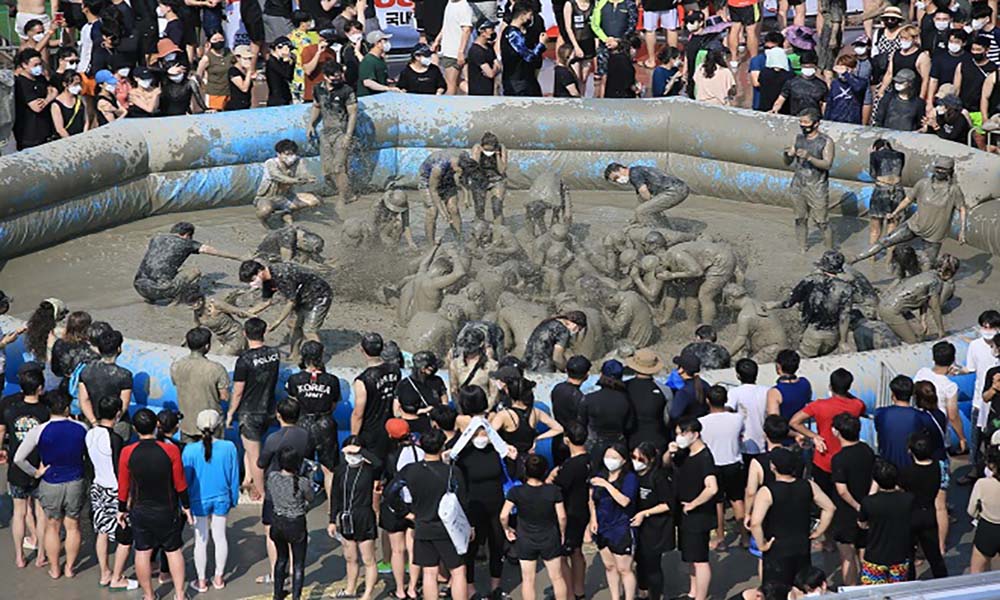
Nestled along the picturesque coast of the Yellow Sea, the Boryeong Mud Festival has become an internationally acclaimed event, drawing millions of revelers to the small town of Boryeong, South Korea, each July. What began as a local promotion for Boryeong’s mineral-rich mud cosmetics has evolved into a globally recognized celebration of mud, wellness, and communal joy.
Cultural Significance: The roots of the Boryeong Mud Festival lie in the belief that the mud found in the region’s mud flats possesses therapeutic and beautifying properties. The festival has transformed from a marketing strategy into an integral part of South Korea’s cultural calendar, emphasizing the connection between nature, health, and celebration. Beyond its cosmetic origins, the mud is seen as a source of rejuvenation and vitality, attracting both locals and international visitors seeking a unique wellness experience.
Unique Traditions and Activities: The festival unfolds with a myriad of activities that go beyond the conventional understanding of celebrations. Mud wrestling arenas, mudslides, and even a mud prison are some of the distinctive features. Participants gleefully engage in playful mud fights, coating themselves in the nutrient-rich mud believed to cleanse and nourish the skin. The festival also hosts competitions, such as the mud king contest, where participants showcase their mud-sculpting skills.
Global Appeal and Participation: What sets the Boryeong Mud Festival apart is its global appeal. Tourists and adventure seekers from around the world descend upon Boryeong to partake in the festivities. The event has gained such popularity that it has become a symbol of South Korea’s vibrant and welcoming culture, fostering international friendships through shared experiences of mud-covered merriment.
Promotion of Regional Tourism: While the festival is undoubtedly a global draw, it also serves as a powerful catalyst for regional tourism. Boryeong, once a relatively unknown town, has now become synonymous with mud festivities. Local businesses, including spas offering mud-based treatments, benefit from the festival’s positive impact on the town’s economy. The festival has successfully positioned Boryeong as a unique destination, showcasing the harmony between nature, tradition, and modern celebration.
In essence, the Boryeong Mud Festival transcends the conventional boundaries of unconventional festivals. It is not merely a celebration but a holistic experience that combines the therapeutic properties of mud with the joy of communal revelry. As participants from diverse backgrounds come together to revel in the mud-covered exuberance, the festival stands as a testament to the universal appeal of joy, wellness, and the unifying power of unique cultural celebrations.
Songkran, Thailand: Where Water, Tradition, and Renewal Converge
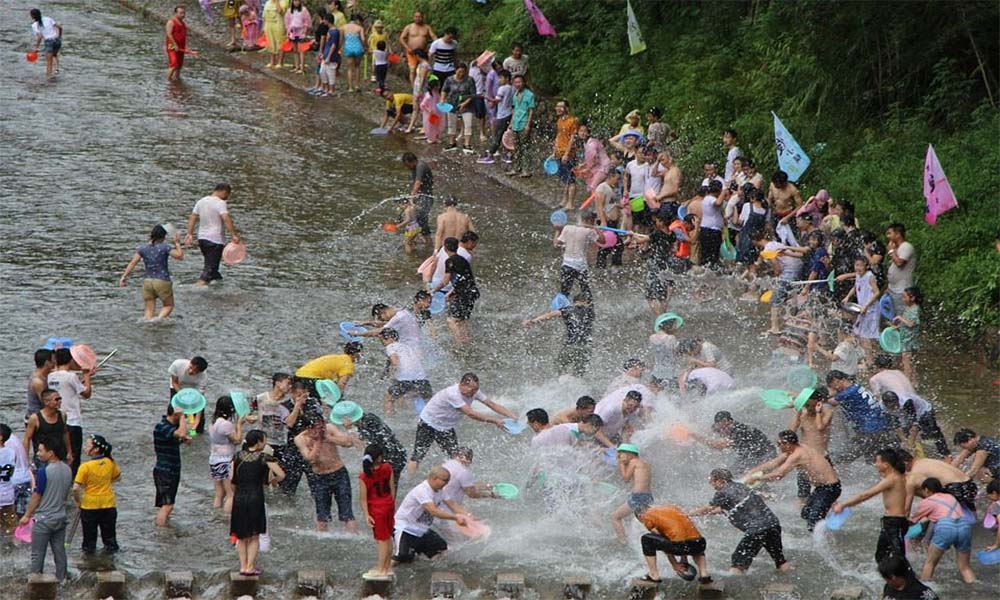
Songkran, also known as the Thai New Year, is a vibrant and unique festival celebrated with unmatched enthusiasm throughout Thailand. While it is widely recognized for its exuberant water fights, Songkran is deeply rooted in tradition and holds significant cultural and spiritual meaning for the Thai people.
Cultural Significance: Songkran marks the traditional Thai New Year, usually celebrated in April. The festival is rooted in Buddhist traditions and is a time for purification, renewal, and paying respects to elders and ancestors. Water, the central element of the celebration, symbolizes cleansing and the washing away of misfortunes, marking a fresh start for the upcoming year.
Water Festival Extravaganza: What sets Songkran apart is the exhilarating water festival that engulfs the entire country. Streets transform into joyful battlegrounds where locals and tourists alike engage in spirited water fights. Buckets, water guns, and hoses become the weapons of choice, turning urban spaces into a canvas of laughter and delight. The water festivities extend beyond mere play; they represent the communal spirit and shared joy that define Thai culture.
Traditional Rituals: Amidst the water revelry, traditional rituals are observed to honor the cultural and spiritual aspects of Songkran. One of the key customs involves pouring scented water over the hands of elders as a gesture of respect and seeking blessings for the new year. This act of pouring water on Buddha statues and monks is a symbolic expression of purification and gratitude.
Family Reunions and Temple Visits: Songkran is a time for family reunions, where people travel across the country to be with their loved ones. Temple visits are an integral part of the celebration, with elaborate ceremonies taking place to honor ancestors and seek blessings for the future. Many Thais take part in making merit by offering food to monks and contributing to community activities.
Regional Variations: While the essence of Songkran remains consistent across Thailand, there are regional variations that add to the festival’s diversity. In the northern city of Chiang Mai, for example, a grand procession featuring Buddha images takes place, attracting thousands of participants. Each region may also have its unique customs and events during Songkran, showcasing the rich cultural tapestry of the country.
Songkran is a celebration that beautifully encapsulates the spirit of Thailand—where tradition, spirituality, and exuberance converge. The water festival, though globally renowned, is just one facet of a multifaceted event that holds deep cultural significance. Songkran is not just a festival; it’s a collective expression of joy, renewal, and the enduring traditions that bind the Thai people together in a colorful tapestry of celebration and cultural pride.
La Tomatina, Spain: A Riot of Tomatoes in the Heart of Buñol
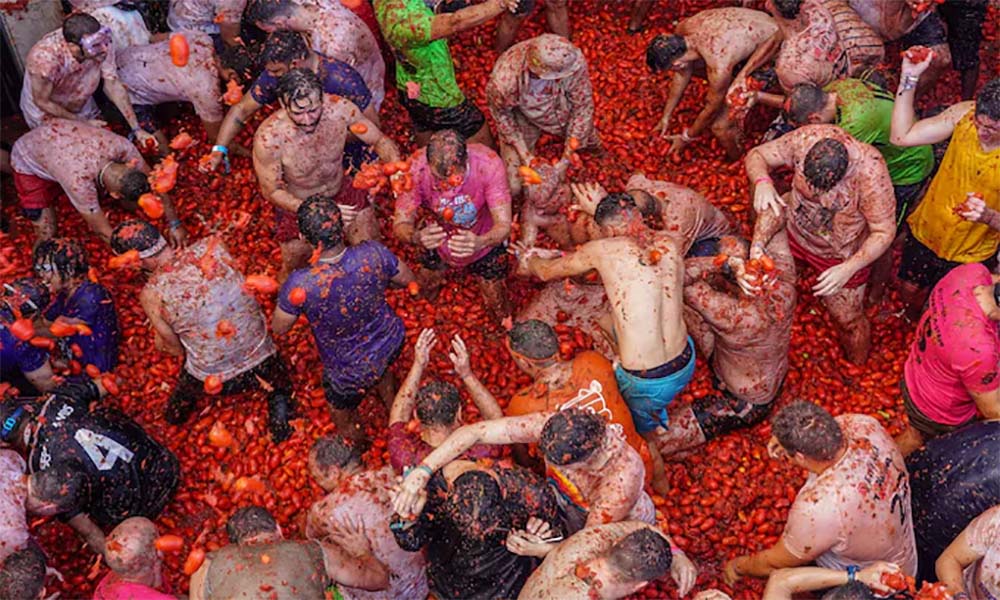
La Tomatina, one of the world’s most unusual and exuberant unconventional festivals, takes place annually in the small town of Buñol, located in the Valencia region of Spain. Renowned for its sheer flamboyance, La Tomatina centers around the playful and chaotic throwing of ripe tomatoes, turning the streets into a sea of red. This unique celebration has evolved into a global spectacle, attracting participants from all corners of the world.
Historical Roots: La Tomatina traces its roots back to 1945 when a group of young people engaged in a spontaneous tomato fight during a parade. The authorities, initially displeased, eventually recognized the festival’s potential and officially embraced it. Over the decades, La Tomatina has grown from a local tradition to an internationally acclaimed event, symbolizing the joy of spontaneity and the vibrant spirit of Spanish culture.
Cultural Significance: While La Tomatina may seem like a mere frivolous event, it holds cultural significance beyond the tomato-throwing chaos. The festival embodies a sense of release and freedom, allowing participants to let loose and engage in unrestrained joy. It’s a celebration of life, camaraderie, and the ability to find joy in the midst of the unexpected—a sentiment deeply ingrained in the Spanish way of life.
The Tomato Battle: The heart of La Tomatina lies in the tomato battle that ensues on the last Wednesday of August each year. Thousands of participants, both locals and international visitors, gather in the town square armed with overripe tomatoes. As the signal is given, the tomato frenzy begins, transforming the narrow streets of Buñol into a squishy battlefield. The air is filled with the delightful chaos of laughter, tomato squelches, and jubilation.
Community Bonding and Festive Atmosphere: Beyond the tomato throwing, La Tomatina fosters a strong sense of community and togetherness. The festival brings people from diverse backgrounds together to share in the unique experience, transcending cultural and linguistic barriers. The festivities extend beyond the main event, with music, dance, and traditional Spanish cuisine adding to the festive atmosphere.
Environmental Considerations: In recent years, there has been a growing awareness of the environmental impact of La Tomatina. Efforts have been made to use overripe or unsellable tomatoes to minimize waste. Additionally, the local authorities have implemented measures to ensure the safety and well-being of participants, emphasizing responsible enjoyment of the festival.
La Tomatina is more than just a tomato fight; it’s a testament to the Spanish spirit of celebration and living in the moment. The festival has become a global symbol of joyful abandon, attracting thrill-seekers and curious travelers alike. While its roots lie in a spontaneous burst of fun, La Tomatina has evolved into a carefully orchestrated, yet delightfully messy, celebration of life, community, and the sheer joy that can be found in the unexpected.
Dia de los Muertos (Day of the Dead), Mexico: A Colorful Celebration of Life and Remembrance

Dia de los Muertos, or the Day of the Dead, is a vibrant and deeply rooted Mexican celebration that honors and remembers loved ones who have passed away. Far from being a somber occasion, this multi-day festival, which typically spans from October 31 to November 2, is a joyful and colorful homage to the cycle of life and death.
Cultural Significance: Dia de los Muertos is not about mourning; rather, it is a celebration of the deceased and a recognition of death as a natural part of the human experience. Rooted in indigenous beliefs and fused with Catholicism, the festival is a unique blend of pre-Hispanic rituals and colonial-era traditions. The celebration reflects the Mexican people’s profound connection to their ancestors, fostering a sense of continuity and community.
Elaborate Altars (Ofrendas): At the heart of Dia de los Muertos are the ofrendas, or altars, created by families to honor their departed loved ones. These altars are elaborate displays adorned with photographs, favorite foods, beverages, and personal mementos of the deceased. Marigold flowers, known as cempasúchil, are a prominent feature, believed to guide the spirits back to the living world. Candles, incense, and sugar skulls are also commonly included in these vibrant displays.
Graveyard Celebrations: Families visit cemeteries to clean and decorate the graves of their relatives. The atmosphere is festive, with music, dance, and food transforming graveyards into lively spaces. It is a time for storytelling, sharing anecdotes, and remembering the personalities and stories of those who have passed away. The belief is that the spirits of the departed return to join in the celebration with the living.
Calaveras and Catrinas: Calaveras, or skulls, are a ubiquitous symbol of Dia de los Muertos. Intricately decorated sugar skulls, often inscribed with the names of the deceased, are both offerings and keepsakes. The elegant and dressed-up skeletal figures known as Catrinas also play a significant role. Originally created by artist Jose Guadalupe Posada, Catrinas represent the idea that death is universal, transcending social and economic differences.
Community Celebrations and Parades: Dia de los Muertos is a communal celebration, with neighborhoods and towns coming together for processions, parades, and public festivities. The streets are filled with color, music, and the vibrant attire of revelers. Traditional Mexican dishes, such as tamales and mole, are prepared and shared, emphasizing the idea that the deceased are still part of the community.
Contemporary Artistic Expressions: In addition to traditional celebrations, Dia de los Muertos has influenced contemporary art, literature, and cinema. The festival’s imagery and symbolism have become iconic elements in Mexican and global popular culture, resonating with people worldwide.
Dia de los Muertos is a celebration that encapsulates the Mexican people’s unique perspective on death—a perspective that embraces it as an integral part of life. The festival’s rich traditions, vibrant displays, and communal spirit make it a distinctive and deeply meaningful cultural event that has transcended borders, inviting the world to join in the joyous remembrance of those who came before.
Up Helly Aa, Scotland: A Fiery Norse Celebration in the Shetland Islands
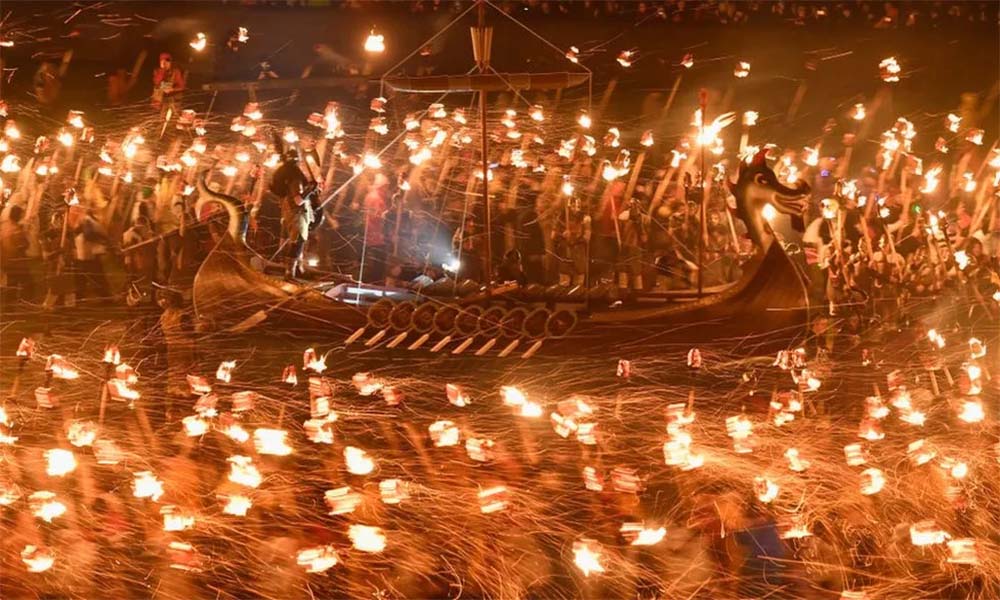
Up Helly Aa, a unique and fiery festival held annually in the Shetland Islands of Scotland, stands as a testament to the region’s Norse heritage and the enduring spirit of community. This event, which takes place in January, revolves around a grand procession, culminating in the symbolic burning of a Viking longship. Up Helly Aa is not only a celebration of Shetland’s rich history but also a vibrant expression of solidarity and identity among its inhabitants.
Norse Roots and Historical Connection: The festival’s roots can be traced back to the influence of Norse settlers who inhabited the Shetland Islands over a millennium ago. The event pays homage to these seafaring ancestors, with participants embracing Viking traditions and customs. This historical connection is a source of pride for the Shetland community, and Up Helly Aa serves as a living tribute to their maritime and cultural heritage.
Guizer Jarl and Viking Squad: Central to Up Helly Aa is the role of the Guizer Jarl, a chief Viking, who leads the proceedings. The Guizer Jarl, adorned in elaborate Viking attire, presides over a group of costumed participants known as the Jarl Squad. Each squad member represents a Viking warrior, complete with intricately crafted shields, helmets, and weaponry. The Jarl Squad’s commitment to historical accuracy and attention to detail is a testament to the festival’s authenticity.
Grand Procession and Galley Burning: The highlight of Up Helly Aa is the torch-lit procession that winds its way through the streets of Lerwick, the capital of the Shetland Islands. Accompanied by the sounds of drums and the haunting melodies of Shetland’s fiddles, the procession is a mesmerizing spectacle. As the procession reaches its climax, the participants encircle a life-sized replica Viking longship. The culmination of the festival is marked by the dramatic burning of the galley, symbolizing the end of the winter season and the rebirth of the year.
Community Spirit and Identity: Up Helly Aa is more than a historical reenactment; it is a celebration of community spirit and a shared sense of identity. The festival involves people of all ages, fostering a strong bond among Shetlanders. The communal effort required to organize such an elaborate event, from crafting costumes to building the galley, enhances a sense of togetherness and pride in Shetland’s unique cultural heritage.
Influence on Shetland Culture: Up Helly Aa has become an integral part of Shetland’s cultural landscape. It has influenced various aspects of local life, from music and literature to visual arts. The festival serves as an inspiration for creative expression, contributing to the preservation and promotion of Shetland’s distinctive identity.
Up Helly Aa is more than a winter festival—it is a living link to Shetland’s Norse past and a celebration of the tight-knit community that calls the islands home. As the flames of the galley rise against the winter night sky, Up Helly Aa illuminates the enduring spirit of Shetland, showcasing a unique blend of history, tradition, and community that sets this festival apart on the global cultural stage.
As we conclude this global tour of unconventional festivals, we find ourselves immersed in the rich tapestry of cultures that breathe life into each celebration. From the mineral-rich mud of Boryeong, through the scented waters of Songkran, the tomato-strewn streets of La Tomatina, the vibrant altars of Dia de los Muertos, to the fiery spectacle of Up Helly Aa, these unconventional festivals reflect the unique spirit of their communities. Beyond the revelry and rituals, they embody resilience, the joy of communal bonds, and the celebration of life in all its forms. In exploring these unconventional festivals, we’ve not only uncovered the beauty of diverse traditions but also witnessed the universal human desire to come together, celebrate, and embrace the essence of what makes each culture special. These festivals serve as powerful reminders that, despite our differences, the world shares a collective spirit of joy, unity, and the enduring celebration of the human experience.

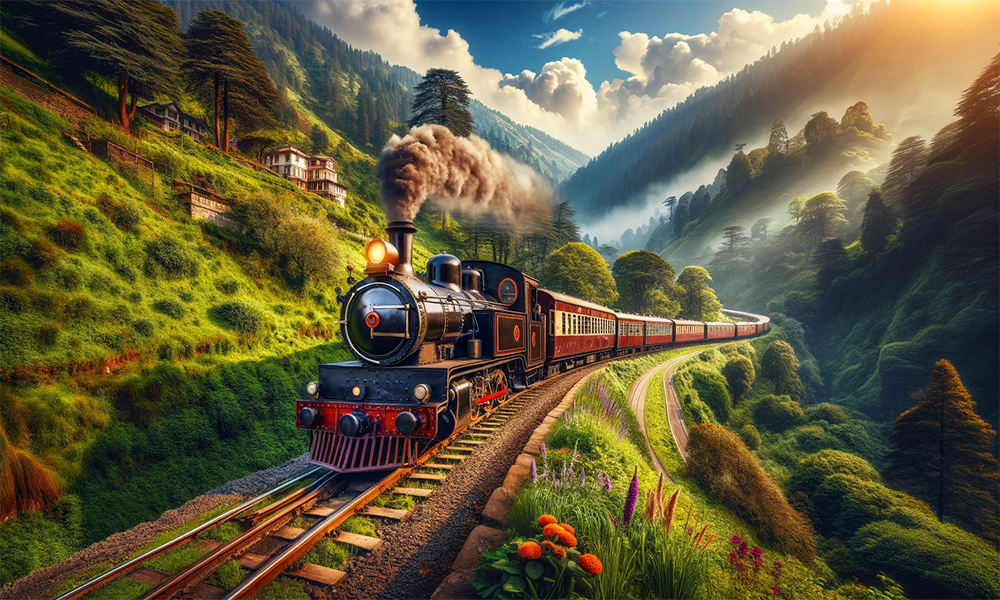

Thanks for posting. I really enjoyed reading it, especially because it addressed my problem. It helped me a lot and I hope it will help others too.
Thanks
May I request more information on the subject? All of your articles are extremely useful to me. Thank you!
Sure. What more information do you want to ask